Timeline of the Rise of Budism Art in India
The legendary Siddhārtha Gautama, as well known equally Buddha, once said: "Improve than a m hollow words, is one word that brings peace." The Buddhist fine art seems to proceed the wise words of 1 of the most historic religious figures in the world. The simple message and the inner peace that the artworks inspire in the viewer are responsible for the appeal of the Buddhist fine art amongst the appreciators around the world. In the 5th and quaternary centuries B.C., the time of the great thinkers such every bit Plato and Socrates in Greece, Laozi, and Confucius in China, India had its ain great philosopher, thinker, and inspirational effigy – Buddha. Later on his expiry, the faith we know today developed and crossed the borders of its homeland and spread across the world.
Siddhartha who later became Buddha was a prince born into the Kapilavastu imperial family unit. It was predicted that he would get a great conqueror, of the concrete earth or the globe of the mind. The story we all know is that Siddhartha sat in the yogic meditation under a banyan tree and achieved enlightenment. Since so, he became known as Buddha – The Enlightened One. He rejected asceticism and luxury. He was an advocate for a life of skilful thoughts and intentions, with the goal of reaching Nirvana, the extinguishing of the fires of attachment, disfavor, and ignorance, that cause rebirth, and suffering.
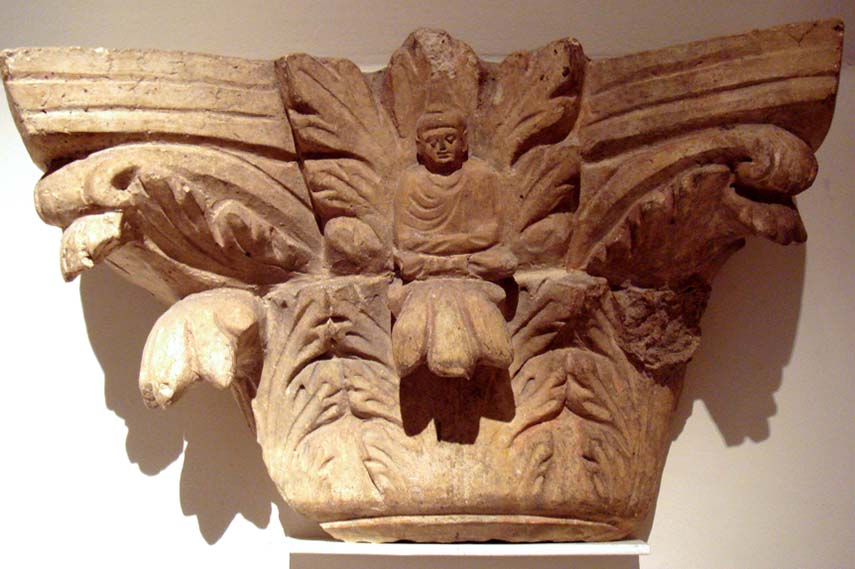
Early on Instances of Buddhist Art
When Buddha died, his body was cremated and divided into several relic caskets known as stupas. The relic of Buddha and other holy figures were the first known examples of Buddhist art. These sacred relics are divided into three categories: Saririka – the physical relics of Buddha; Uddesika – the religious symbols that include the image of Buddha, stupas, Dharmacakra (Wheel of the Dharma); Paribhogika – the articles used by the Buddha. The earliest recovered pieces of Buddhist art originate from the Hindu and East-Roman fine art with references to Buddha's life.
These early examples belong to the category of the Pre-iconic phase of Buddhist art that lasted from the 5th to the 1st century B.C. in this menstruation, Buddha was represented through the aniconic symbols such equally the Bodhi tree, an empty throne, the horse with no rider, Buddha's footprints, and the Wheel of Dharma. According to Alfred A. Foucher, these anthropomorphic images of the Buddha are considered a result of a Greco-Buddhist interaction. Other scholars argue that at a time information technology was considered inappropriate to describe the one who had achieved Nirvana. Still, during the 2nd and the 1st century B.C., sculptures became more than explicit and began depicting scenes from Buddha's life, just still represented through symbolism, rather than in his human being form. In the 1st century B.C. the artists from India started adopting rock instead of brick, thatch, bamboo, and woods. They congenital stone gateways and railings to the stupas and covered them with sculptures that depicted the events from the life of the Buddha, as well every bit his previous 550 lives.
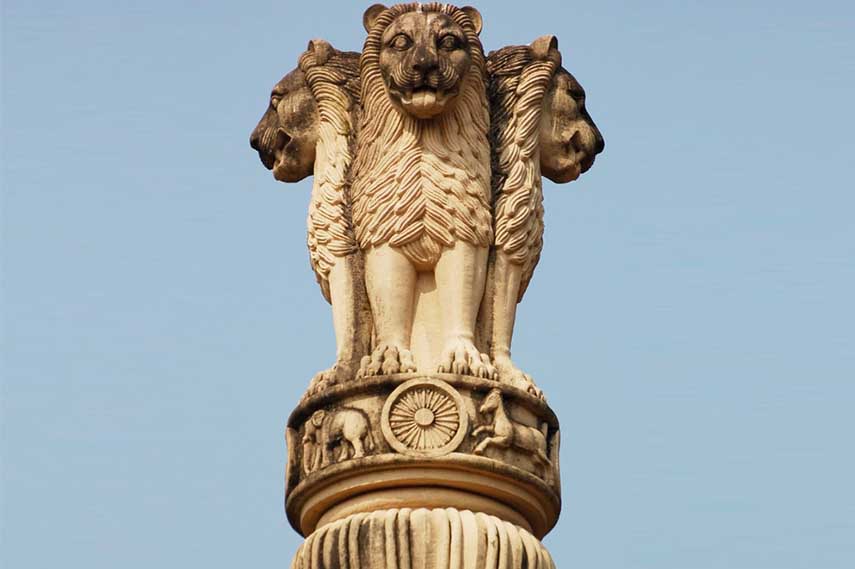
The Wheel of Dharma
When Buddha first reached awakening, he is said to have explained his findings to 5 ascetics. This get-go teaching is marked as the moment at which the Wheel of Dharma was activated. As information technology was non permitted to depict Buddha in his human form, the wheel became the symbol of Buddhism, often carved into the artworks and created by the craftsmen of that fourth dimension. Dharmacakra is the symbol taken from Jain tradition, an aboriginal Indian religion that promotes ahimsa (non-violence) towards all the living beings on this Earth. One of the earliest instances of Dharma art is the Sarnath pillar, i of the Pillars of Ashoka. These pillars were built past the Mauryan king Ashoka in the 3rd century BC. In this pillar, the lion serves as a reference to Buddha, and at the bottom, the wheels and an ox are emerging from a stylized lotus flower.
The bodily Bike of Dharma is comprised of three basic parts: the hub, the rim, and the spokes. It was said that the circular shape of the Dharma represents the perfection of the Buddhist teaching, the rim represents mindfulness and concentration which are the glue that holds the dharma together, the hub is a symbol of moral subject area, and the three swirls on the hub tin sometimes stand for the Three Treasures – Buddha, dharma, and sangha. The spokes can symbolize diverse things depending on their number. When the Dharma wheel has four spokes, which is very rare, they stand for the Four Noble Truths: dukkha (the truth of suffering), samudaya (the truth of the cause of suffering), nirhodha (the truth of the finish of suffering), and magga (the truth of the path that frees one from suffering). When it has eight spokes, the most unremarkably used one, they stand for the Eightfold Path. When information technology has ten spokes, they stand for the ten directions, and when it has twelve spokes they represent the Twelve Links of Dependent Origination. When the wheel has 24 spokes, they represent the combination of the Twelve links and liberation from Samsara, and this blazon of bicycle is also known equally Ashoka Chakra. Finally, when the bicycle has 31 spokes, they represent the 31 realms of beingness, taken from aboriginal Buddhist cosmology.
"Three things cannot be long hidden: the sun, the moon, and the truth." – Buddha
This paraphrased quote by the Buddha can be interpreted in a number of ways, and each one can be as genuine equally the next i. Withal, we have chosen to translate is as the Three Turnings of the Dharma. It is said that the Buddha had turned the bike three times, which represent three teachings of Buddhism. The get-go one he taught when he rose from meditation and explained the Four Noble Truths. The second turning marked the inception of Mahayana Buddhism, and it is said to have happened some 500 years later on the showtime, and it presented the platonic of do as a bodhisattva, the i who seeks to bring enlightenment to all beings. The third turning offered the focus on the Buddha nature, which basically meant that all beings can accomplish enlightenment as they are all fundamentally of Buddha nature.
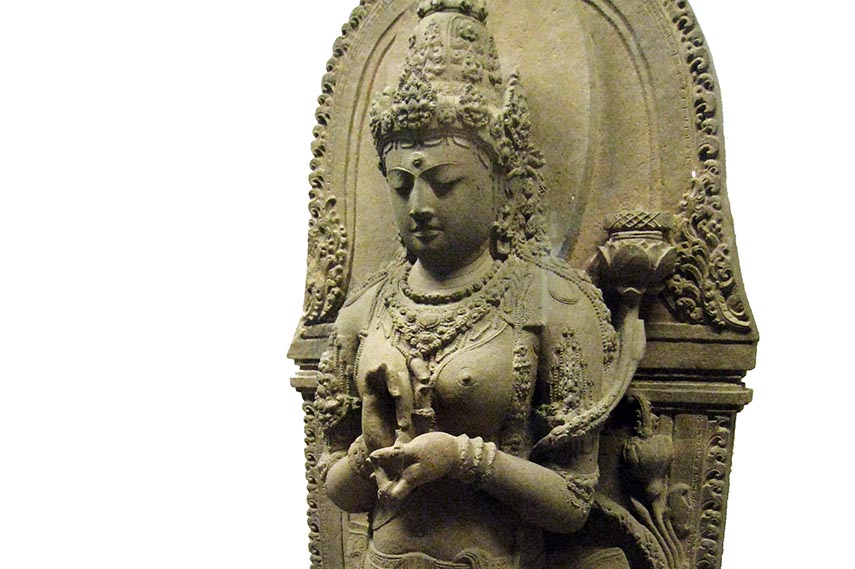
Iconic Phase – 1st Century A.D. to the Present
The 1st century Advertisement. brought something completely new to the Buddhist art. The artist started to depict Buddha in his man form, and one of the first examples of this was establish in the North-West India in the area known as Gandhara, the aboriginal proper name for Islamic republic of pakistan. The Gandhara artists combined the Buddhist symbolism with the elements from the Hellenistic world and created a unique manner. They created young Buddhas with curly pilus that resembled the Roman statues of Apollo, they dressed him in the robe that covered both shoulders with heavy folds that reminded of the toga. By the 2d century, the philosophers of the Mahayana institute that the artworks could serve as a reminder of the Buddha'due south teachings, the Dharma, and non merely as the effigy of worship. The start images of Buddha appeared during the Kushan Dynasty and the time of King Kanishka and can be found at two locations, Mathura, and the previously mentioned Gandhara. Mathuran artworks were less influenced by the craftsmen who came to the Eastward with Alexander the Bully, and they sprouted out of the Indian yogic traditions and were primarily washed in ruddy sandstone.
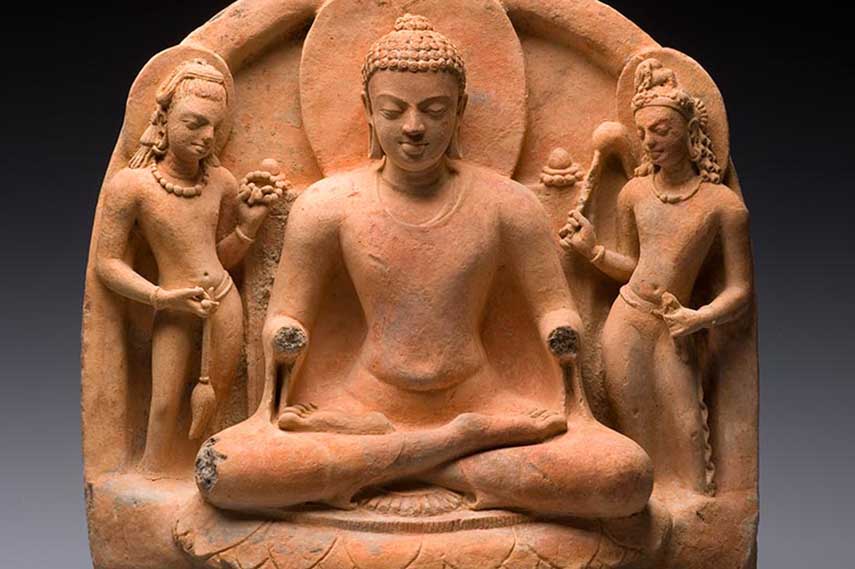
The Gupta Menstruation
For a few more centuries the Buddhist fine art connected to develop in India, flourishing in the Gupta period, also known every bit the golden historic period, which lasted from the 4th to the 6th century. Virtually all of the works we tin can see today are religious sculptures, though the period saw the emergence of the Buddha effigy and Jain Tirthankara figures. The Gupta period is significant for its creations of an "ideal paradigm" of the Buddha, achieved through the combination of his traits from the region of Gandhara and the sensual course of Mathuran artists. These Gupta Buddhas after became the model for the generations of artists who followed, in post-Gupta and Pala India, in Nepal, Thailand, and Republic of indonesia.
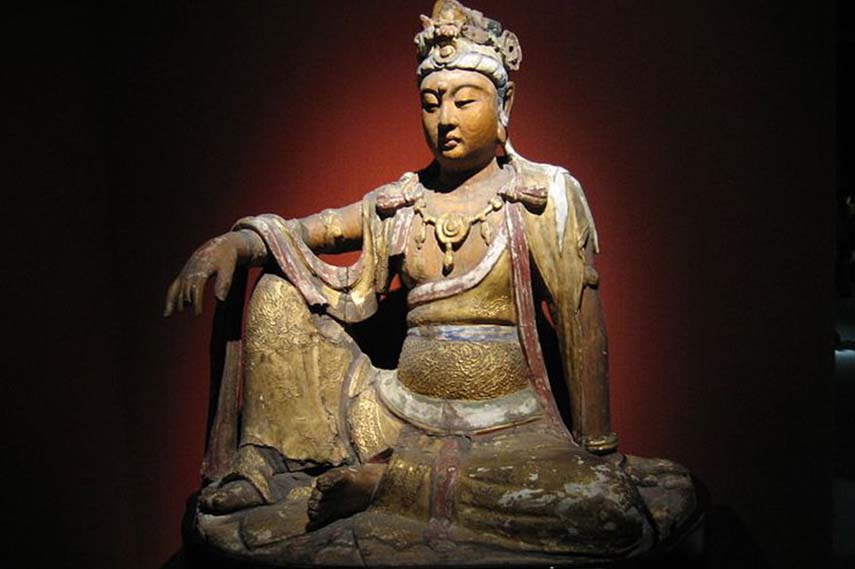
Buddhist Art Outside of India
Every bit Buddhism expanded to the places outside of Bharat, its aesthetics mixed with other influences, leading to different views on the religion and art. At that place are ii main routes of Buddhist art: the Northern road, with the inception in the 1st century Advertisement. in Central Asia, Tibet, Bhutan, Korea, Nihon, and China where the Mahayana Buddhism was prominent, and the Southern route in Myanmar, Thailand, Vietnam, and Cambodia, where Theravada Buddhism was ascendant.
Northern Road
In Afghanistan, Buddhist fine art thrived until the spread of Islam that came in the seventh century. The all-time examples of Afghan fine art were the Buddhas of Bamyan, and the sculptures that blended Hellenistic, or Greco-Roman influence and post-Gupta mannerism. However, the Islamic religion was not tolerant towards Buddhism, as it was no the faith "of the Book", and it was considered to depend on idolatry. In Islamic art, homo figurative art was prohibited, which led to the systematic destruction of Buddhist art past the Taliban regime.
In Central Asia, the expansion of the Quondam Han to the Due west acquired the increased influence of the Hellenistic civilizations, peculiarly the Greco-Bactrian Kingdom on the Buddhist art. This led to the expansion of Buddhism to the communities on the Silk Road, where some cities were filled with stupas and Buddhist monasteries. The eastern part of Primal Asia was rich with Serindian art, influenced past the Indian and Hellenistic sculptures, besides equally by the Gandharan style.
In People's republic of china, Buddhism appeared in the 1st century AD., and it brought the idea of statue to Chinese art. One of the earliest instances of Buddhist fine art in Communist china is the sculpture found in the Han dynasty burial in the province of Sichuan, created circa 200 Advertizing., showing a heavy Gandharan influence. During the Tang dynasty, artists were influenced by the Gupta period, but in the year 845, the emperor Wuzong prohibited the foreign religions, including Zoroastrianism, Nestorianism, and Buddhism, in favor of the ethnic Daoism. He seized all Buddhist artworks and forced the religion to go underground. Under the Song dynasty, however, Chan Buddhism (which volition afterward become Zen Buddhism) prospered. Mainland china is a country with the richest drove of Buddhist fine art, including the Mogao Caves in the province of Gansu, the Longmen Grottoes in Henan province, and the Dazu Rock Carvings, which are the most important Buddhist sculptural sites.
In Japan, Buddhism was discovered in the 6th century, and accepted the religion in the centuries to come. The government often sponsored the cosmos of numerous sculptures and paintings. The Japanese mode was influenced by the Chinese, Korean, Indian, and Hellenistic styles, and the menstruum betwixt the 8th and the 13th century was especially fruitful for the development of Buddhist art. In the twelfth century, the Japanese Zen art was at its acme, characterized past paintings and poetry (especially haiku), every bit well every bit past the Ikebana art, and the Chanouy tea ceremony.
In Tibet, one of the nigh meaning creations was the mandala, a diagram of a "divine temple" comprised of a square enclosed by a circle, the purpose of which was to assistance with the focus of attention during meditation. The strongest influences here were the Gupta and Hindu art.
Southern Buddhist Route
In Myanmar, the strongest influences came from Republic of india. Beikhtano temple in fundamental Myanmar was the earliest instance of Buddhist art, and it dates back to the time between the 1st and the 5th century. The influences of Gupta and postal service-Gupta periods tin can exist seen, and later on the jeweled statues of the Buddha were created.
Cambodia saw the expansion of Buddhism under the Khmer Empire when over 900 temples were built all over the country. Angkor had a Buddhist temple complex where a large number of sculptures and other artworks are preserved.
In Thailand, Buddhist art was influenced by Bharat and Gupta tradition, likewise as by the Cambodian Khmer fine art, based on the Mahayana, with the creation of Bodhisattvas in large numbers. In the 13th century when Theravada Buddhism was introduced, highly stylized images became prominent, and during the Ayutthaya flow, the Buddha was represented with lavish clothing and jeweled ornaments.
Indonesia was heavily influenced by India as well, accepting both Mahayana and Vajrayana Buddhism. A big number of statues of Bodhisattvas tin can be establish all over the region. But probably the richest remnants of Buddhist art can be seen in Coffee and Sumatra, ane of the near important ones being the temple of Borobudur, which is actually the largest Buddhist building in the world. The temple was created after the Buddhist concept of the universe, the Mandala, comprised of 505 images of the Buddha and a bell-shaped stupa. The oldest Buddhist building in Indonesia is the Batu Jaya stupas that date back to the 4th century AD. In Sumatra, there are the temples Muara Takus and Muaro Jambi, and the almost cute example of this type of fine art is the statue of Prajnaparamita, the goddess of wisdom from Singhasari. Unfortunately, the Buddhist art of the region was destabilized by the expansion of Islam in the 13th century, notwithstanding, some remnants of this art can however be found in Indonesia.
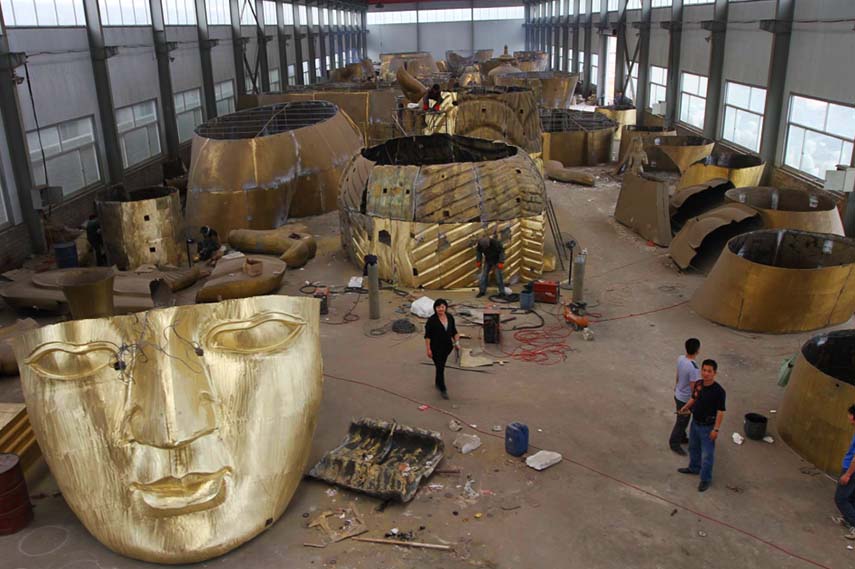
Contemporary Buddhist Art
Contrary to pop belief, Buddhist art is non just the relic of the by. At that place are many prominent contemporary artists who create such artworks, especially with the new-establish involvement in the Buddhist faith we are witnessing today. Not only visual arts, but literature likewise has expressed the Buddhist influence, equally seen in the works of Transcendentalists Ralph Waldo Emerson and Henry David Thoreau, too every bit in writings of Walt Whitman, J.D. Salinger (who was profoundly influenced by Zen Buddhism), Jack Kerouac'due south The Dharma Bums and Big Sur, Allen Ginsberg'southward Howl, and Gary Snyder's Turtle Island. When it comes to visual art, the great Marcel Duchamp was greatly influenced past the philosophy of Buddhism, and the painters Mark Tobey, Agnes Martin, Jasper Johns, Brice Marden, , and Advertizement Reinhardt reported that they found sources of inspiration in Buddhism. The artists Tenzing Rigdol and Gonkar Gyatso address Buddhist themes in their works, although the primary goal of their art is their own artistic expression and not the devotion to the religion. In Mongolia, a super large-calibration statue of the standing Maitreya Bodhisattva is to be built nether the spiritual direction of Dalai Lama. Tsherin Sherpa depicts Buddhist symbols in his works, forth with Tenzin Norbu, Dedron, and Kesang Lamdark.
Meanwhile, bank check out works past Agnes Martin on our marketplace!
So, what can we conclude? As Buddhism is becoming more and more accepted by the middle-class people it is certain that the Buddhist art will continue to prosper. In the fourth dimension of great political and religious turmoil, a peaceful religion such equally Buddhism is getting its second (or is information technology third) comeback with its pacifist teachings and non-trigger-happy rules. Albert Einstein one time said, "If there is any religion that could respond to the needs of modern science, it would exist Buddhism." And indeed, information technology is. The serenity and the humility that Buddhism promotes are what made it then pop over the class of centuries, and now, more than always, we need that tranquility to at-home the overwhelming violence and sadness we are facing every day. We demand to go over the petty differences that the gild imposes on us, and we need to discover that inner peace in lodge to flourish and reach our full potentials as the dominant fauna on this planet. Nosotros demand to reach deep into our souls and find the beauty in all things living and in all fascinating works of art we take at our disposal. We need to become over the things that draw us autonomously, and accept the things that bring united states together, and art is but one of them.
"Greater in battle than the man who would conquer a yard-chiliad men, is he who would conquer just one – himself" – Gautama Buddha
All images are for illustrative purposes only.
Featured image: The Big Buddha in Kamakura via onmarkproductions.com
Image in the slider: The Cycle of Dharma via wikipedia.org
Source: https://www.widewalls.ch/magazine/history-of-buddhist-art
0 Response to "Timeline of the Rise of Budism Art in India"
Post a Comment